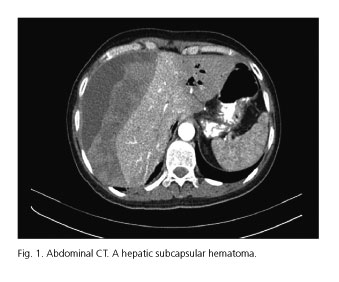My SciELO
Services on Demand
Journal
Article
Indicators
-
 Cited by SciELO
Cited by SciELO -
 Access statistics
Access statistics
Related links
-
 Cited by Google
Cited by Google -
 Similars in
SciELO
Similars in
SciELO -
 Similars in Google
Similars in Google
Share
Revista Española de Enfermedades Digestivas
Print version ISSN 1130-0108
Rev. esp. enferm. dig. vol.109 n.11 Madrid Nov. 2017
https://dx.doi.org/10.17235/reed.2017.5123/2017
LETTERS TO THE EDITOR
A post-endoscopic retrograde cholangiopancreatography subcapsular hepatic hematoma
Hematoma subcapsular hepático post-colangiopancreatografía retrógrada endoscópica
Key words: Hematoma. ERCP. Complication.
Palabras clave: Hematoma. CPRE. Complicación.
Dear Editor,
With regard to the case published by Del Moral Martínez et al. (1), we would like to report a recent clinical case in our center. Endoscopic retrograde cholangiopancreatography (ERCP) is a minimally invasive technique with a low complication rate. A subsequent hepatic hematoma is an exceptional occurrence (1-3).
Case Report
Recently, a 43-year-old cholecystectomized patient underwent an ERCP due to choledocholithiasis. Some hours after the procedure, the patient experienced abdominal pain in the right upper quadrant and anemia. An abdominal computed tomography (CT) showed a subcapsular hepatic hematoma of 16 x 7 x 16 cm that compressed and displaced the hepatic parenchyma towards the midline (Fig. 1). Angio-TC was subsequently performed without contrast extravasation.
Due to the clinical stability and the absence of active bleeding, the patient was managed conservatively and monitored in the Intensive Care Unit (ICU), where she remained hemodynamically stable. After ten days, a control CT identified a persistent collection. A percutaneous drainage was consequently performed and 1,000 ml of blood content were extracted. The evolution was favorable and the patient was discharged 12 days later. However, she required a repeat drainage a few days later and about 1,100 ml were extracted. Subsequently, she was asymptomatic.
Discussion
Post-ERCP hepatic subcapsular hematoma is a rare complication (3,4). The etiology is not clear, although it can originate from the damage of intrahepatic vessels by a metallic guide. The management is usually conservative, with a good evolution (5).
Rocío Soler-Humanes, Miguel Ángel Suárez-Muñoz and Blanca García-García
Department of Digestive and General Surgery.
Hospital Universitario Virgen de la Victoria. Málaga, Spain
References
1. Del Moral Martínez M, Delgado Maroto A, Cervilla Sáez de Tejada ME, et al. Hepatic hematoma after ERCP: Two new case reports. Rev Esp Enferm Dig 2017;109(6):470-3. DOI: 10.17235/reed.2017.4237/2016. [ Links ]
2. Servide MJ, Prieto M, Marquina T. Hepatic subcapsular hematoma: A rare late complication after ERCP. Rev Esp Enferm Dig 2016; 108(4):234-5. [ Links ]
3. González-López R, García Cano E, Espinosa González O, et al. Tratamiento quirúrgico para hematoma subcapsular hepático posterior a colangiografía retrógrada endoscópica; caso inusual. Cir Cir 2015;83(6):506-9. DOI: 10.1016/j.circir.2015.05.028. [ Links ]
4. Fei BY, Li CH. Subcapsular hepatic haematoma after endoscopic retrograde cholangiopancrea-tography: An unusual case. World J Gastroenterol 2013;19(9):1502-4. DOI: 10.3748/wjg.v19.i9.1502. [ Links ]
5. Zizzo M, Lanaia A, Barbieri I, et al. Hepatic hematoma after endoscopic retrograde cholangiopancreatography. A case report and review of literature. Medicine 2015;94(26):1041. DOI: 10.1097/MD.0000000000001041. [ Links ]











 text in
text in 


